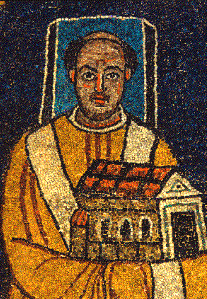Pope Paschal I
|
Pope Saint Paschal I |
|
|---|---|

Paschal I holding the Church of Santa Prassede wearing a zuchetto and pallium. Mosaic portrait at Church of Saint Praxedis in Rome.
|
|
| Papacy began | 25 January 817 |
| Papacy ended | 11 February 824 |
| Predecessor | Stephen IV |
| Successor | Eugene II |
| Personal details | |
| Birth name | Pascale Massimi |
| Born | 775 Rome, Papal States |
| Died | 11 February 824 Rome, Papal States |
| Buried | Santa Prassede, Rome |
| Sainthood | |
| Feast day | 11 February |
| Venerated in | Roman Catholic Church |
| Attributes |
|
|
Papal styles of Pope Paschal I |
|
|---|---|
 |
|
| Reference style | His Holiness |
| Spoken style | Your Holiness |
| Religious style | Holy Father |
| Posthumous style | Saint |
Pope Saint Paschal I (Latin: Paschalis I; born Pascale Massimi; died 11 February 824) was Pope from 25 January 817 to his death in 824.
According to the Liber Pontificalis, Paschal was native of Rome and son of Bonosus and Episcopa Theodora. The Liber Censuum says that Paschal was from the Massimo family, as was his predecessor Pope Stephen IV.
Paschal may have been a subdeacon, priest, and abbot of the monastery of St Stephen of the Abyssinians during the papacy of Pope Leo III. According to early modern accounts, Leo III may have elevated Paschal as the cardinal of Santa Prassede. Goodson attributes this account to a "desire to explain the attention that the pope so lavishly and prominently paid to that church later in his career."
Paschal became pope on January 25, 817, just one day after the sudden death of Pope Stephen IV. This decision occurred before the sanction of the emperor Louis the Pious had been obtained, and was a circumstance for which it was one of his first tasks to apologize. Paschal advised the emperor that the decision had been made to avoid factional strife in Rome.
According to the Liber Pontificalis, Pope Paschal's papal legate Theodore returned with a document titled Pactum cum Pashali pontiff, in which the Emperor congratulated Paschal, recognized his sovereignty over the Papal States and guaranteed the free election of future pontiffs. . This document was challenged by later historians as a forgery.
At the time of Paschal's reign, Rome was "in a tumult." "Neither the papacy nor the nobles of the ever held control for very long."
Paschal gave shelter to exiled monks from the Byzantine Empire who were persecuted for their opposition to iconoclasm, and invited mosaic artists to decorate churches in Rome. This is known because Byzantine Emperor Michael II wrote to Frankish King Louis the Pious in an attempt to stop it.
...
Wikipedia
